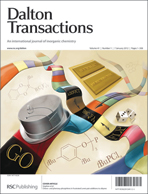The redox properties of [HIPTN3N]Mo complexes (where HIPTN3N = (3,5-(2,4,6-i-Pr3C6H2)2C6H3NCH2CH2)3N) involved in the catalytic dinitrogen reduction cycle were studied using cyclic voltammetry in fluorobenzene with Bu4NPF6 as the electrolyte. MoN2 (Mo = [HIPTN3N]Mo, E1/2 = −1.96 V vs. Fc+/Fc at a Pt electrode), Mo≡N (E1/2 = −2.68 V vs. Fc+/Fc (Pt)), and [Mo(NH3)]BAr′4 (Ar′ = 3,5-(CF3)2C6H3, E1/2 = −1.53 V vs. Fc+/Fc (Pt)) each undergo a chemically reversible one-electron reduction, while [Mo![[double bond, length as m-dash]](https://www.rsc.org/images/entities/char_e001.gif) NNH2]BAr′4 (E1/2 = −1.50 V vs. Fc+/Fc (Pt)) and [Mo
NNH2]BAr′4 (E1/2 = −1.50 V vs. Fc+/Fc (Pt)) and [Mo![[double bond, length as m-dash]](https://www.rsc.org/images/entities/char_e001.gif) NH]BAr′4 (E1/2 = −1.26 V vs. Fc+/Fc (Pt)) each undergo a one-electron reduction with partial chemical reversibility. The acid employed in the catalytic reduction, [2,4,6-collidinium]BAr′4, reduces irreversibly at −1.11 V vs. Fc+/Fc at Pt and at −2.10 V vs. Fc+/Fc at a glassy carbon electrode. The reduction peak potentials of the Mo complexes shift in the presence of acids. For example, the reduction peak for MoN2 in the presence of [2,4,6-collidinium]BAr′4 at a glassy carbon electrode shifts positively by 130 mV. The shift in reduction potential is explained in terms of reversible hydrogen bonding and/or protonation at a nitrogen site in Mo complexes. The significance of productive and unproductive proton-coupled electron transfer reactions in the catalytic dinitrogen reduction cycle is discussed.
NH]BAr′4 (E1/2 = −1.26 V vs. Fc+/Fc (Pt)) each undergo a one-electron reduction with partial chemical reversibility. The acid employed in the catalytic reduction, [2,4,6-collidinium]BAr′4, reduces irreversibly at −1.11 V vs. Fc+/Fc at Pt and at −2.10 V vs. Fc+/Fc at a glassy carbon electrode. The reduction peak potentials of the Mo complexes shift in the presence of acids. For example, the reduction peak for MoN2 in the presence of [2,4,6-collidinium]BAr′4 at a glassy carbon electrode shifts positively by 130 mV. The shift in reduction potential is explained in terms of reversible hydrogen bonding and/or protonation at a nitrogen site in Mo complexes. The significance of productive and unproductive proton-coupled electron transfer reactions in the catalytic dinitrogen reduction cycle is discussed.
![[double bond, length as m-dash]](https://www.rsc.org/images/entities/char_e001.gif) NNH2]BAr′4 (E1/2 = −1.50 V vs.
NNH2]BAr′4 (E1/2 = −1.50 V vs. ![[double bond, length as m-dash]](https://www.rsc.org/images/entities/char_e001.gif) NH]BAr′4 (E1/2 = −1.26 V vs.
NH]BAr′4 (E1/2 = −1.26 V vs. ![Graphical abstract: An electrochemical investigation of intermediates and processes involved in the catalytic reduction of dinitrogen by [HIPTN3N]Mo (HIPTN3N = (3,5-(2,4,6-i-Pr3C6H2)2C6H3NCH2CH2)3N)](/en/Image/Get?imageInfo.ImageType=GA&imageInfo.ImageIdentifier.ManuscriptID=C1DT11287B&imageInfo.ImageIdentifier.Year=2012)

 Please wait while we load your content...
Please wait while we load your content...